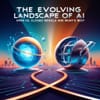The world of artificial intelligence is undergoing rapid change, especially when it comes to the debate between open and closed AI models. For years, open-source AI has been seen as the transparent, collaborative force driving innovation, while closed models, typically guarded by corporations, have been viewed as proprietary tools designed to maximize control and profit. However, the gap between these two approaches is closing faster than many expected, and the lines between open and closed AI are becoming increasingly blurred.
Historically, open AI models, which allow anyone to access and modify the underlying code, were favored by the research community. They fostered collaboration and the free flow of knowledge, enabling a broad range of innovators to experiment and iterate. On the other hand, closed models—usually developed by large tech companies—have been more restricted, often built with the aim of maintaining a competitive edge or monetizing AI capabilities. These models have offered powerful, refined technologies but at a cost: limited access to their inner workings and data.
Now, however, the landscape is shifting. Many leading tech companies, once protective of their AI models, are starting to embrace more open approaches. We’re seeing an increasing number of AI models being released to the public, or at least made accessible under more flexible terms, allowing a wider pool of developers to get involved in their improvement. Notable examples include OpenAI’s GPT models and Google's TensorFlow, which have made significant strides toward democratizing AI. This growing openness has made it easier for startups, researchers, and smaller companies to harness the power of advanced AI without needing to invest heavily in proprietary technology.
At the same time, the lines between open and closed AI are becoming more porous. Even as tech giants release more open models, they also continue to build and refine their closed systems, integrating more flexible or hybrid solutions. For instance, many companies are now offering both open-source versions of their models and commercial versions that come with additional features or support, creating a model where innovation and exclusivity coexist. This hybrid approach allows organizations to maintain control over premium services while contributing to the open-source community, making it easier for businesses and developers to work within the ecosystem that best suits their needs.
The rapid convergence of open and closed models is likely to continue as AI technology matures. The ability to balance openness with controlled, monetizable innovation could ultimately drive AI to become more inclusive, efficient, and accessible. It’s clear that the future of AI won’t be defined by rigid boundaries but by a more fluid approach where openness fosters innovation, and controlled models offer advanced capabilities for specific use cases.


